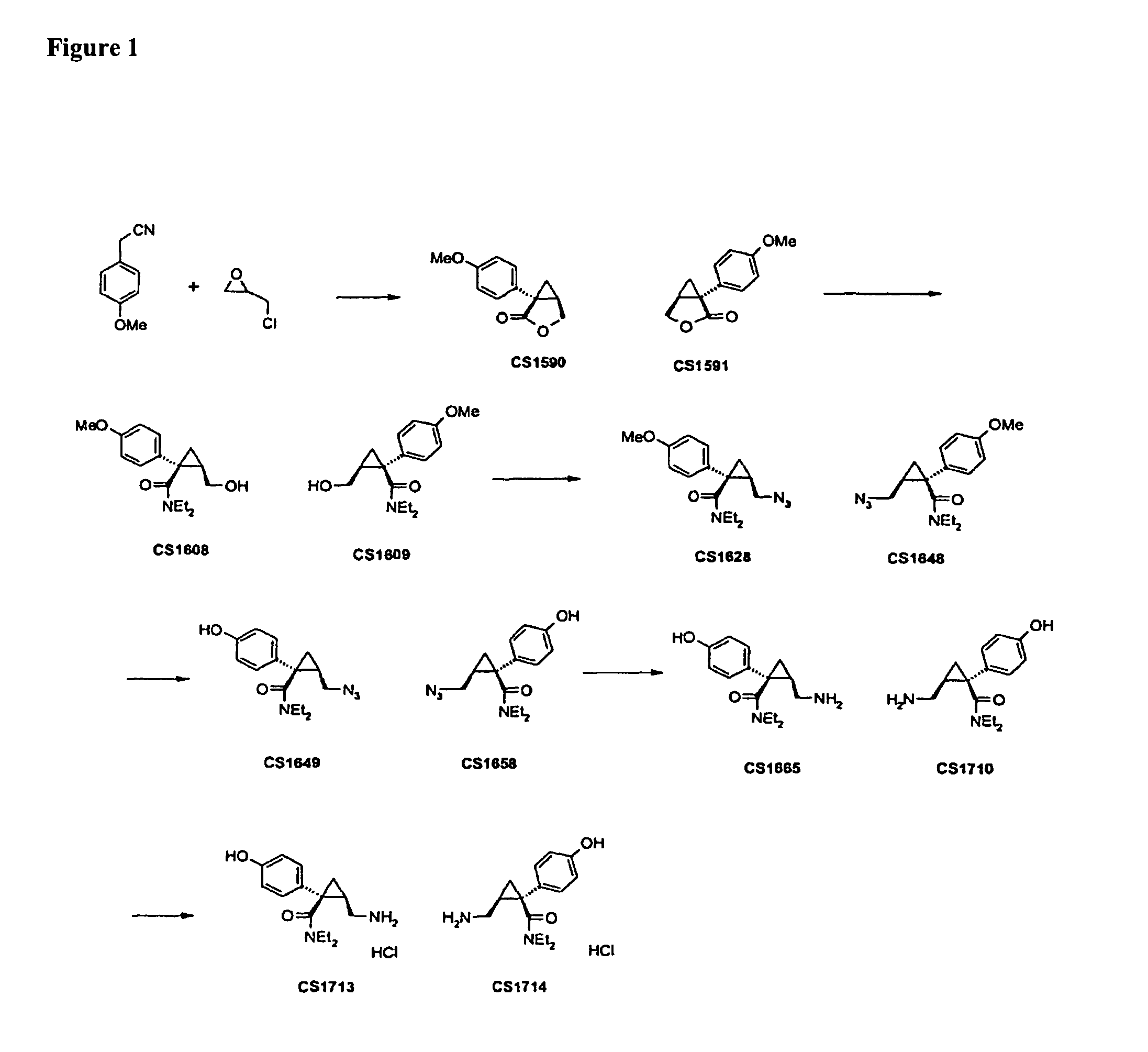Stereoisomers of p-hydroxy-milnacipran, and methods of use thereof
- Summary
- Abstract
- Description
- Claims
- Application Information
AI Technical Summary
Benefits of technology
Problems solved by technology
Method used
Image
Examples
example 1
Synthesis of CS1590 and CS1591
[0307]A 200 mL three neck round bottom flask, equipped with a stir bar, a thermometer and a gas adapter was charged with 4-methoxyphenylacetonitrile (9.38 g, 63.76 mmol) and benzene (70 mL). The reaction mixture was allowed to cool to 0° C. followed by the addition of sodium amide (4.97 g, 127.5 mmol) and stirred an additional 2 hours at this temperature. After this period of time (R)-epichlorhydrine (5.9 g, 63.76 mmol) was added and the resulting reaction mixture was stirred overnight, the solvent was reduced under reduced pressure and the residue was dissolved in ethanol (50 mL) and aqueous potassium hydroxide (1 mol / L, 40 mL). The solution was then heated to reflux overnight followed by addition of concentrated hydrochloric acid to adjust the pH=1. The aqueous phase was extracted with tert.-butylmethylether (200 mL) and ethyl aceate (200 ml). The organic phases were combined, washed with sat. sodium chloride, dried (MgSO4) and the solvent was reduced...
example 2
Synthesis of CS1608 and CS1609
[0308]A 200 mL three neck round bottom flask, equipped with a stir bar, a thermometer and a gas adapter was charged with n-butyllithium (1.6 mol / L, 29.8 mL, 47.7 mmol), cooled to 0° C. followed by the addition of diethylamine (3.49 g, 47.7 mmol). The solution was stirred for 20 min, allowed to cool to −78° C. followed by the addition of a solution of CS1590 (6.08 g, 29.8 mmol) in tetrahydrofuran (50 mL). The reaction mixture was allowed to warm to room temperature overnight, followed by quenching the reaction mixture into an aqueous saturated solution of ammonium chloride (200 ml) and subsequent extraction with ethyl acetate. The organic phase was separated, dried (MgSq4) and the solvent was reduced under reduced pressure to afford crude CS1608 (8.10 g, 98%) which was used without further purification for the next step.
In a similar fashion the desired enantiomer CS1609 was synthesized.
example 3
Synthesis of CS1628 and CS1648
[0309]A 200 mL three neck round bottom flask, equipped with a stir bar, a thermometer and a gas adapter was charged with CS1608 (5.6 g, 20.19 mmol) and N,N-dimethylformamide (20 mL), cooled to 0° C., followed by the addition of sodium azide (5.2 g, 80.76 mmol), triethylamine (10.2 g, 100.95 mmol) and methanesulfochloride (4.6 g, 60.57 mmol). The suspension was stirred for 24 hours at room temperature, quenched into water (200 ml-) and extracted with ethylacetate (2×200 mL), dried (MgS04) and the solvent was reduced under reduced pressure to afford crude CS1628, which was purified by column chromatography on silica gel using heptane / ethyl actetate 5:1 as an eluent to afford CS1628 (2.2 g, 36%) as an off white solid.
In a similar fashion the desired enantiomer CS1648 was synthesized.
PUM
| Property | Measurement | Unit |
|---|---|---|
| Temperature | aaaaa | aaaaa |
| Temperature | aaaaa | aaaaa |
| Molar density | aaaaa | aaaaa |
Abstract
Description
Claims
Application Information
 Login to View More
Login to View More - R&D
- Intellectual Property
- Life Sciences
- Materials
- Tech Scout
- Unparalleled Data Quality
- Higher Quality Content
- 60% Fewer Hallucinations
Browse by: Latest US Patents, China's latest patents, Technical Efficacy Thesaurus, Application Domain, Technology Topic, Popular Technical Reports.
© 2025 PatSnap. All rights reserved.Legal|Privacy policy|Modern Slavery Act Transparency Statement|Sitemap|About US| Contact US: help@patsnap.com



